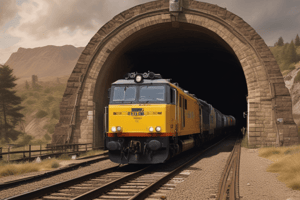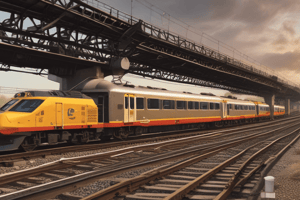Podcast
Questions and Answers
What is the primary purpose of heaping up ballast in the tamping zone?
What is the primary purpose of heaping up ballast in the tamping zone?
- To ensure effective packing (correct)
- To decrease the pressure on the rails
- To increase the speed of the tamping process
- To reduce the weight of the sleepers
What should be done to signal rods, cables, pipes, and other obstructions before tamping?
What should be done to signal rods, cables, pipes, and other obstructions before tamping?
- Cut them off completely
- Remove them preferably
- Mark them clearly and inform the tamping operator (correct)
- Leave them as they are
What is the recommended tamping depth?
What is the recommended tamping depth?
- 25 mm to 30 mm
- 15 mm to 20 mm (correct)
- 20 mm to 25 mm
- 10 mm to 15 mm
What should be done to the sleepers before tamping?
What should be done to the sleepers before tamping?
What is the purpose of clearing ballast on sleepers?
What is the purpose of clearing ballast on sleepers?
What should be done to the expansion gap in rails during tamping?
What should be done to the expansion gap in rails during tamping?
Why should the beginning and end of transitions be marked?
Why should the beginning and end of transitions be marked?
What should be examined during the tamping process?
What should be examined during the tamping process?
What precaution should be observed while carrying out casual renewal of concrete sleepers?
What precaution should be observed while carrying out casual renewal of concrete sleepers?
Why should the ends of concrete sleepers be painted with an approved type of anti-corrosive paint?
Why should the ends of concrete sleepers be painted with an approved type of anti-corrosive paint?
What should be checked by the Keyman during his daily patrol in relation to Elastic Rail clips?
What should be checked by the Keyman during his daily patrol in relation to Elastic Rail clips?
What happens when an Elastic Rail clip is over driven or under driven?
What happens when an Elastic Rail clip is over driven or under driven?
What should be done to prevent corrosion of Elastic Rail clips?
What should be done to prevent corrosion of Elastic Rail clips?
What should be ensured while checking Rubber Pads?
What should be ensured while checking Rubber Pads?
What should be done when rubber pads have developed a permanent set?
What should be done when rubber pads have developed a permanent set?
What can cause loss of toe load in Elastic Rail clips?
What can cause loss of toe load in Elastic Rail clips?
What is the minimum number of points at which free rails are supported?
What is the minimum number of points at which free rails are supported?
What is the centre-to-centre spacing of supports for welded rail panels?
What is the centre-to-centre spacing of supports for welded rail panels?
What is the guideline for stacking of rails?
What is the guideline for stacking of rails?
What is the method of detection of rail flaws?
What is the method of detection of rail flaws?
Why should rail ends be examined during the lubrication of rail joints?
Why should rail ends be examined during the lubrication of rail joints?
What is the requirement for laying new rails in the track?
What is the requirement for laying new rails in the track?
What is the primary objective of the sample track?
What is the primary objective of the sample track?
Who should be trained by RDSO for ultrasonic testing of rails?
Who should be trained by RDSO for ultrasonic testing of rails?
Who should inspect the work done by a gang?
Who should inspect the work done by a gang?
What is the primary cause of corrosion in rails?
What is the primary cause of corrosion in rails?
What should be checked during the examination of a gang's work?
What should be checked during the examination of a gang's work?
How often should the JE/SSE/P.Way examine tools and equipment?
How often should the JE/SSE/P.Way examine tools and equipment?
What should be recorded in the gang diaries?
What should be recorded in the gang diaries?
What is one of the minimum equipment that each gang should have?
What is one of the minimum equipment that each gang should have?
What is the purpose of the Gang Mate's Muster Sheet?
What is the purpose of the Gang Mate's Muster Sheet?
How many detonators should each gang have?
How many detonators should each gang have?
What should JE/SSE/P.Way ensure every man in each gang is aware of?
What should JE/SSE/P.Way ensure every man in each gang is aware of?
What is the primary reason for screening of ballast?
What is the primary reason for screening of ballast?
What happens to ballast due to excessive rainfall and dropping of fines and ore?
What happens to ballast due to excessive rainfall and dropping of fines and ore?
What is the term used to describe the screening of the entire ballast right up to the formation level/sub-ballast level?
What is the term used to describe the screening of the entire ballast right up to the formation level/sub-ballast level?
What is the result of deep screening on the ballast bed?
What is the result of deep screening on the ballast bed?
What should JE/SSE/P.Way instruct the men to do with the tools?
What should JE/SSE/P.Way instruct the men to do with the tools?
What should be done to the men in each gang periodically and on appointment, promotion or transfer?
What should be done to the men in each gang periodically and on appointment, promotion or transfer?
What is the primary focus of the instructions given by JE/SSE/P.Way?
What is the primary focus of the instructions given by JE/SSE/P.Way?
Flashcards are hidden until you start studying
Study Notes
Pre-Tamping Preparations
- Heaping up of ballast in the tamping zone to ensure effective packing
- Making up of low cess
- Cleaning of pumping joints and providing additional clean ballast, where necessary
- Attention to hogged joints before tamping
- Tightening of all fittings and fastenings like fish bolts and elastic fastenings, and replacement of worn out fittings
- Renewing broken and damaged sleepers
- Squaring of sleepers and spacing adjustment; re-gauging to be done as necessary
- Adjusting creep and expansion gap in rails
- Examination of rails for cracks, sleepers, and fastenings
- Survey for realignment of curves, which are badly out of alignment
- Clearing of ballast on sleepers to make them visible to the operator
Attention during Tamping
- The tamping depth (gap between the top edge of the tamping blade and the bottom edge of the sleeper in closed position of the tamping tool) should be adjusted to 15 mm to 20 mm
- Care should be taken to ensure that tamping tools are inserted centrally between the sleepers into the ballast to avoid any damage to the sleepers
- Free rails should be supported at least at four points, evenly along their length
- Welded rail panels should be spread on cess as to rest evenly along their entire length on supports spaced at 4-meter center to center to prevent formation of kinks
- Each stack of the rail should be of the same section and class
Inspection of Rails in Service
- Detection of rail flaws is done by visual examination of the rail and by ultra-sonic flaw detection (USFD) of rails
- Visual examination of rails includes examining rail ends for cracks during lubrication of rail joints by cleaning the surface of the rail by wire brush and using a magnifying glass
- USFD testing of service rails should be done regularly, and no rail untested by USFD should be laid in the track
- JE/SSE/P.Way carrying out the ultra-sonic testing of rails should be trained by RDSO
Causes of Rail Deterioration
- Corrosion and rusting are caused by acid gases dissolved in the film of moisture, which frequently coats the rails
Casual Renewal of Concrete Sleepers
- Precautions indicated in Para 623 (4) should be observed during casual renewal of concrete sleepers
- Special care should be taken to consolidate the shoulders of the ballast section after renewal of the sleepers
Corrosion of Steel in Concrete Sleepers
- Both ends of concrete sleepers should be painted with an approved type of anti-corrosive paint at the concrete sleeper manufacturing plant to prevent corrosion of the exposed ends of pre-stressing wires
Maintenance of Concrete Sleeper Fastenings
- Elastic Rail clips should be checked by the Keyman during his daily petrol to ensure correct driving of the clip
- Rubber Pads should be in correct position, and those that have developed a permanent set should be renewed
Checking Work of Gangs by JE/SSE/P.Way
- The work done by a gang should be examined for alignment, surfacing, and boxing throughout
- The JE/SSE/P.Way should inspect rails and sleepers and their fastenings and check cross levels, gauge, squareness of sleepers, packing, joint maintenance, profile of ballast, and depths of cess below rail level
Deep Screening of Ballast
- Deep screening of ballast is essential to restore the resilience and elasticity of the ballast bed, resulting in improved running quality of track
- Screening should be carried out periodically, especially in situations where the track is poorly drained due to bad formation, ballast attrition, excessive rainfall, and dropping of fines and ore
Studying That Suits You
Use AI to generate personalized quizzes and flashcards to suit your learning preferences.




